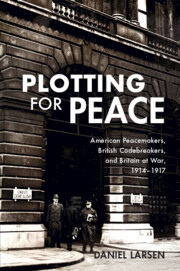Book contents
- Plotting for Peace
- Plotting for Peace
- Copyright page
- Dedication
- Contents
- Figures
- Map
- Graph and Table
- Dramatis Personae
- Preface
- Acknowledgements
- Maps
- Introduction
- 1 The First Year of War
- 2 Strategy
- 3 Negotiations
- 4 Deliberations
- 5 The Gamble
- 6 The Knock-Out Blow
- 7 The Fall of Asquith
- 8 Peace Moves
- 9 The Zimmermann Telegram and Wilson’s Move to War
- Conclusion
- Book part
- Notes
- Bibliography
- Index
2 - Strategy
August–December 1915
Published online by Cambridge University Press: 26 March 2021
- Plotting for Peace
- Plotting for Peace
- Copyright page
- Dedication
- Contents
- Figures
- Map
- Graph and Table
- Dramatis Personae
- Preface
- Acknowledgements
- Maps
- Introduction
- 1 The First Year of War
- 2 Strategy
- 3 Negotiations
- 4 Deliberations
- 5 The Gamble
- 6 The Knock-Out Blow
- 7 The Fall of Asquith
- 8 Peace Moves
- 9 The Zimmermann Telegram and Wilson’s Move to War
- Conclusion
- Book part
- Notes
- Bibliography
- Index
Summary
As the British faced financial crisis in the United States, the Treasury developed a strategy to fight the war while sustaining their ever-increasing reliance on American supplies. A near-failure of a large Anglo-French loan in the United States revealed that American investors were unwilling to finance these supplies themselves, a revelation that should have been a decisive moment for British war strategy. Instead, McKenna faced a significant faction in the Cabinet who dismissed these concerns as overblown. This faction demanded large increases in the size of the British Army and imposing conscription on the British public – demands that led to a series of political crises for Prime Minister H. H. Asquith to manage.
- Type
- Chapter
- Information
- Plotting for PeaceAmerican Peacemakers, British Codebreakers, and Britain at War, 1914–1917, pp. 48 - 70Publisher: Cambridge University PressPrint publication year: 2021

